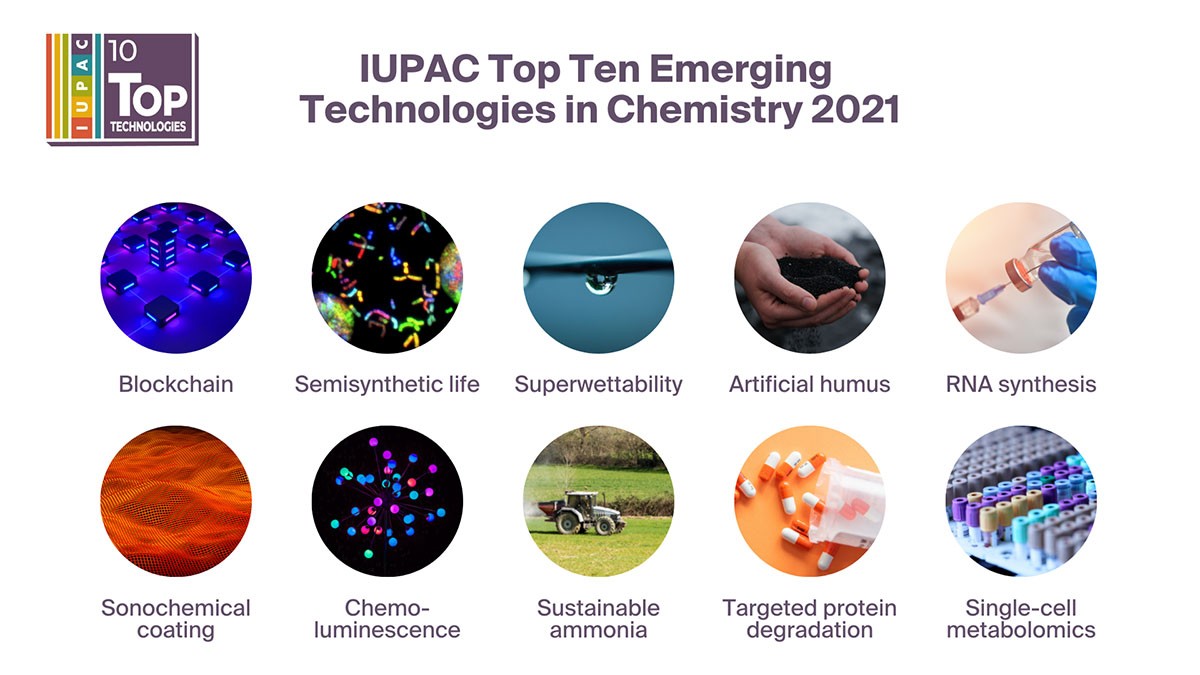
2021 Announcement of Top Ten Emerging Technologies in Chemistry
The International Union of Pure and Applied Chemistry (IUPAC) has released the results of the search for the 2021 Top Ten Emerging Technologies in Chemistry. The goal of this project is to showcase the transformative value of Chemistry and to inform the general public on the potential of the chemical sciences to foster the well-being of Society and the sustainability of our Planet.
The 2021 finalists are (in alphabetical order):
• Artificial humic matter from biomass
• Blockchain technology
• Chemiluminescence for biological use
• Chemical synthesis of RNA and DNA
• Semi-synthetic life
• Single cell metabolomics
• Sonochemical coatings
• Superwettability
• Sustainable production of ammonia
• Targeted protein degradation
Artificial humic matter from biomass
Organic substances decompose into humic matter, adding valuable nutrients to soil. But the process produces carbon dioxide and methane. Making artificial humic matter is far more sustainable and efficient. When added to soils, the synthetic mixtures can improve soil quality, boost crop yields and cut down on fertiliser use. One approach is to ‘cook’ organic matter in hot water with ash (hydrothermal humification).
Blockchain technology
This type of database, where data is stored in linked blocks, could prove useful in science and industry to improve transparency and accessibility of data. Blockchains can store different types of information but the most common use so far has been as a digital ledger for transactions. Significantly, blockchains are decentralised so no single person or group has control, and the data entered is permanently recorded and accessible. UK chemists have experimented with using blockchain to trace a series of simple computational calculations, where each stage of the process is documented and shared within the digital ledger. Chemical companies have already created blockchain-based systems to modernise supply chains, allowing secure transactions and continuous tracking of goods.
Imaging life with chemiluminescence
Molecules that emit light are incredibly useful in many applications, whether in detecting blood at crime scenes (luminol) or lighting up biological samples in microscopy (green fluorescent proteins). Research continues to develop new materials, such as probes based on dioxetanes. These probes emit bright light even in the presence of water without the aid of organic solvents, making them particularly suitable for imaging living systems. Dioxetane probes could be used to detect certain types of tumours and pathogenic bacteria such as Salmonella.
Chemical synthesis of RNA and DNA
The triumph of mRNA-based Covid vaccines has paved the way for more novel therapies targeting cancer, diabetes and other infectious diseases. The chemical synthesis of RNA and DNA is now fully automated and available in several benchtop devices. But the technology continues to advance, such as using inkjet printing principles to deposit DNA on to silicon chips as alternatives to conventional magnetic solutions.
Superwettability
Superwettable materials, which combine two extreme states – hydrophobicity and hydrophilicity – have unique fluid dynamics and reactivity. To create them, researchers have taken inspiration from nature by studying lotus leaves, which are extremely hard to wet, and spider silk, which excels at attracting water. They have created nanostructured superwettable surfaces on metals, polymers and textiles for potential applications including splitting water, removing contaminants, self-cleaning textiles, oil separation and cooling.
Semi-synthetic life
The creation of synthetic nucleotides has allowed chemists to build artificial biochemical machinery, developing new systems to minimise the number of transcription and translation errors. They provide new chemical tools for the design of targeted treatments, including Thor-707, which attacks metastatic solid tumours, and is currently in clinical trials.
Single cell metabolomics (SCM)
SCM can determine the metabolic profiles of individual cells. With the development of equipment and techniques such as mass spectrometry, SCM analysis has become possible for a wide range of biological samples. One application, particularly relevant in pandemic times, is to improve understanding of infection processes and the interactions between an invading virus and cells.
Sonochemical coatings
Using sonic waves to trigger chemical reactions has great potential to manufacture innovative materials, particularly for surfaces such as antimicrobial coatings or smart coatings that change colour when they detect pathogenic bacteria. Applications in development include extending the shelf-life of foods, and boosting the performance and stability of lithium-ion batteries. Industry is now looking at scaling up this technology and developing methods that enable continuous production of coated materials.
Sustainable ammonia production
The Haber–Bosch process for the synthesis of ammonia is one of the most important industrial chemical reactions. But it’s highly energy-intensive and emits significant levels of carbon dioxide. The search is on to find greener ways to make ammonia including novel catalysts to reduce nitrogen. One approach is direct electrochemical synthesis in aqueous, molten salt or solid state electrolytic cells. Other research is investigating nitrogen-reducing enzymes in bacteria and cyanobacteria.
Targeted protein degradation
This technology allows researchers to control the amount of a harmful protein in the body rather than trying to change or inhibit its activity. A single degrader drug can destroy several disease-causing proteins through proteasome degradation. This technology has already attracted investment from big pharma and led to multiple start-ups. Clinical trials have shown its promise in the treatment of cancer, but it also has potential in other diseases related to protein accumulation, such as Parkinson’s and Alzheimer’s.